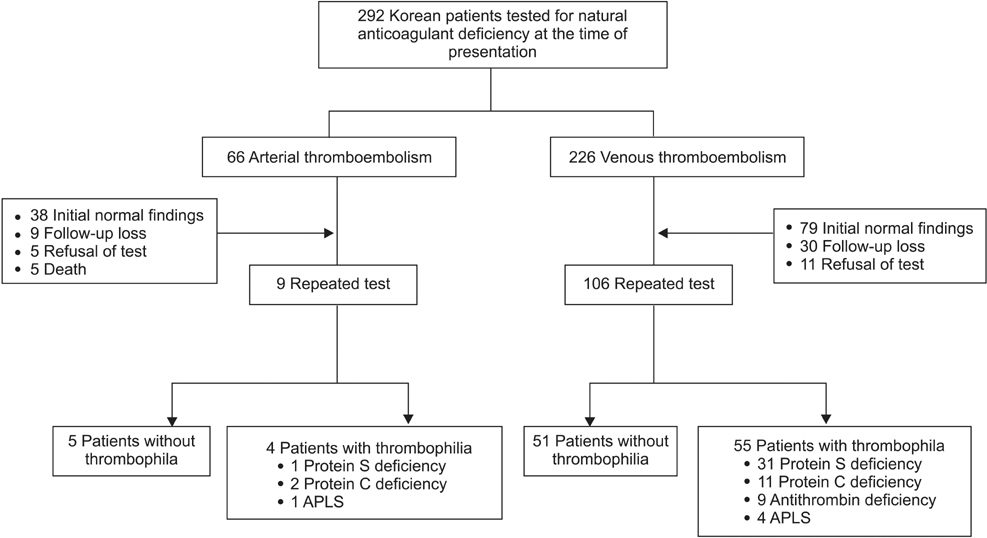Ann Surg Treat Res.
2016 Jun;90(6):340-345. 10.4174/astr.2016.90.6.340.
Thrombophilia in Korean patients with arterial or venous thromboembolisms
- Affiliations
-
- 1Division of Vascular Surgery, Department of Surgery, Kyungpook National University School of Medicine, Daegu, Korea. hkkim6260@knu.ac.kr
- KMID: 2164795
- DOI: http://doi.org/10.4174/astr.2016.90.6.340
Abstract
- PURPOSE
To determine the prevalence of thrombophilia in Korean patients with an arterial thromboembolism (ATE) or a venous thromboembolism (VTE), and to evaluate the characteristic of VTE in patients with thrombophilia.
METHODS
Hospital records of 294 patients (228 with VTE, 66 with ATE) including two foreign ones (mean age, 51.4 years) who underwent thrombophilia testing between August 2006 and March 2015 were reviewed retrospectively. In general, such screening was performed according to the guidelines of the international consensus statement for VTE. Thrombophilia testing included evaluations of the factor V Leiden and prothrombin G20210A mutations, levels of proteins C and S and antithrombin, and antiphospholipid antibody syndrome (APLS).
RESULTS
A factor V Leiden mutation was not found in the 292 Korean patients. A prothrombin G21210A mutation was investigated in 33 patients but none was found. Among 226 Korean patients with VTE, 130 demonstrated no thrombophilia and 55 patients did after exclusion of 41 patients without confirmatory test. The most common form was protein S deficiency (31 of 55, 56%) followed by protein C deficiency, antithrombin deficiency, and APLS. When comparing patients with a VTE or deep vein thrombosis (DVT) according to the presence of thrombophilia, thrombophilia was associated with younger age (P = 0.001 for VTE; P < 0.001 for DVT) and a family history (P < 0.001 for VTE and DVT).
CONCLUSION
We did not find any factor V Leiden mutation in Korean subjects at high risk for thrombophilia. Therefore, this testing is not warranted. Thrombophilia was associated with VTE in younger age and a family history.
MeSH Terms
Figure
Cited by 1 articles
-
Cerebrovascular complications during pregnancy and postpartum
Jeong-Ho Hong
J Neurocrit Care. 2019;12(1):20-29. doi: 10.18700/jnc.190087.
Reference
-
1. European Genetics Foundation. Cardiovascular Disease Educational and Research Trust. International Union of Angiology. Mediterranean League on Thromboembolism. Nicolaides AN, Breddin HK, et al. Thrombophilia and venous thromboembolism. International consensus statement. Guidelines according to scientific evidence. Int Angiol. 2005; 24:1–26.2. Shen MC, Lin JS, Tsay W. High prevalence of antithrombin III, protein C and protein S deficiency, but no factor V Leiden mutation in venous thrombophilic Chinese patients in Taiwan. Thromb Res. 1997; 87:377–385.3. Zama T, Murata M, Ono F, Watanabe K, Watanabe R, Moriki T, et al. Low prevalence of activated protein C resistance and coagulation factor V Arg506 to Gln mutation among Japanese patients with various forms of thrombosis, and normal individuals. Int J Hematol. 1996; 65:71–78.4. Kim TW, Kim WK, Lee JH, Kim SB, Kim SW, Suh C, et al. Low prevalence of activated protein C resistance and coagulation factor V Arg506 to Gln mutation among Korean patients with deep vein thrombosis. J Korean Med Sci. 1998; 13:587–590.5. Kim HJ, Seo JY, Lee KO, Bang SH, Lee ST, Ki CS, et al. Distinct frequencies and mutation spectrums of genetic thrombophilia in Korea in comparison with other Asian countries both in patients with thromboembolism and in the general population. Haematologica. 2014; 99:561–569.6. Ridker PM, Miletich JP, Hennekens CH, Buring JE. Ethnic distribution of factor V Leiden in 4047 men and women. Implications for venous thromboembolism screening. JAMA. 1997; 277:1305–1307.7. Roldan V, Lecumberri R, Munoz-Torrero JF, Vicente V, Rocha E, Brenner B, et al. Thrombophilia testing in patients with venous thromboembolism. Findings from the RIETE registry. Thromb Res. 2009; 124:174–177.8. Seki T, Okayama H, Kumagai T, Kumasaka N, Sakuma M, Isoyama S, et al. Arg506Gln mutation of the coagulation factor V gene not detected in Japanese pulmonary thromboembolism. Heart Vessels. 1998; 13:195–198.9. White RH. The epidemiology of venous thromboembolism. Circulation. 2003; 107:23 Suppl 1. I4–I8.10. Heit JA, O'Fallon WM, Petterson TM, Lohse CM, Silverstein MD, Mohr DN, et al. Relative impact of risk factors for deep vein thrombosis and pulmonary embolism: a population-based study. Arch Intern Med. 2002; 162:1245–1248.11. Hamasaki N, Kuma H, Tsuda H. Activated protein C anticoagulant system dysfunction and thrombophilia in Asia. Ann Lab Med. 2013; 33:8–13.12. Kinoshita S, Iida H, Inoue S, Watanabe K, Kurihara M, Wada Y, et al. Protein S and protein C gene mutations in Japanese deep vein thrombosis patients. Clin Biochem. 2005; 38:908–915.13. Mateo J, Oliver A, Borrell M, Sala N, Fontcuberta J. Laboratory evaluation and clinical characteristics of 2,132 consecutive unselected patients with venous thromboembolism: results of the Spanish Multicentric Study on Thrombophilia (EMET-Study). Thromb Haemost. 1997; 77:444–451.14. Seligsohn U, Lubetsky A. Genetic susceptibility to venous thrombosis. N Engl J Med. 2001; 344:1222–1231.15. Weingarz L, Schwonberg J, Schindewolf M, Hecking C, Wolf Z, Erbe M, et al. Prevalence of thrombophilia according to age at the first manifestation of venous thromboembolism: results from the MAISTHRO registry. Br J Haematol. 2013; 163:655–665.16. Di Minno MN, Ambrosino P, Ageno W, Rosendaal F, Di Minno G, Dentali F. Natural anticoagulants deficiency and the risk of venous thromboembolism: a meta-analysis of observational studies. Thromb Res. 2015; 135:923–932.17. De Stefano V, Rossi E, Paciaroni K, Leone G. Screening for inherited thrombophilia: indications and therapeutic implications. Haematologica. 2002; 87:1095–1108.
- Full Text Links
- Actions
-
Cited
- CITED
-
- Close
- Share
- Similar articles
-
- Neonatal Thromboembolic Disorders
- Recurrent Acute Pulmonary Embolism Associated With Protein S Deficiency
- Inadvertent Arterial Catheterization of Central Venous Catheter: A Case Report
- Recurrent Deep Vein Thrombosis due to Thrombophilia
- Activated Protein C Anticoagulant System Dysfunction and Thrombophilia in Asia


